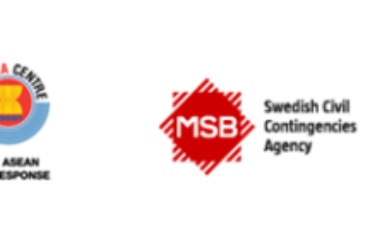
EU-SAHA
PROJECT STEERING COMMITTEE MEETING
The Integrated Programme in Enhancing the Capacity of AHA Centre and ASEAN Emergency Response Mechanisms (EU-SAHA) began in early 2020,, and although many activities have been pushed back due to the global pandemic, the AHA Centre continued with the implementation in the programme’s inaugural year. On 8 December, 2020, the Project Steering Committee for the EU-SAHA came together in an online environment to undertake their first formal meeting, aimed to provide a report and updates on the implementation process after the first year.
Engaged in the meeting were all key members of the Project Steering Committee (PSC) – including representatives from the AHA Centre, EU Mission to ASEAN, the Disaster Management and Humanitarian Assistance Division of ASEAN Secretariat, the Estonian Rescue Board (ERB), and the Swedish Civil Contingencies Agency (MSB). The meeting was also co-chaired by the Singapore Civil Defence Force (SCDF), the National Disaster Risk Reduction and Management Council (NDRRMC) of the Philippines, and the EU Mission to ASEAN.
The first PSC meeting primarily reported on the four key outputs or results that form the target of EU-SAHA overall. While the pandemic created obstacles for the achievement of outcomes as originally planned, there was still considerable progress in activities that form each of the key programmatic outcomes.
OUTPUT/RESULT 1:
Efforts undertaken during 2020 as part of this output/result included the hiring of specialist staff, as well as the implementation of a capacity development project. There were eight positions fully-funded by EU-SAHA filled during the year, alongside eight partially-funded positions. Alongside this, a key component of the EU-SAHA programme – namely the Leveraging ASEAN Capacities for Emergency Response (LACER) project – was implemented with the support of the ERB and MSB. This AHA Centre institutional and operational capacity strengthening project developed and validated its baseline information with the AHA Centre, and finalised a workplan for the coming phases that was also presented at the PSC meeting.
OUTPUT/RESULT 2:
Activities implemented during 2020 under Output/Result 2 were primarily focused on strengthening multi-stakeholder engagement and communication, and increasing brand awareness of the AHA Centre. The included the development of the EU-SAHA Communication and Visibility Plan, and the publication of EU-SAHA fact sheets to support basic communication of the project. Communication activities supporting the responses to a number of tropical storms in Viet Nam and Super Typhoon GONI (ROLLY) in the Philippines were also implemented, as were other communications efforts to support AHA Centre events and engagements during the year. Finally, recruitment was undertaken for a consultant to deliver a media monitoring and journalism workshop, with the event targeted to take place early in 2021.
OUTPUT/RESULT 3:
The key activity underneath this output/result was the publication of the 2018 After-Action Review – an evaluative and reflective report that encompassed the AHA Centre’s largest year of disaster response since its establishment in November 2011.
OUTPUT/RESULT 4:
Working towards the fourth output/result in 2020 included the review and improvement of the AHA Centre’s current Knowledge and Change Management (KCM) systems. This entailed reviewing the original strategy developed in 2016, and updating it to suit the current context of the AHA Centre. This included re-developing the KCM framework, developing a taxonomy system and guideline for documentation, reviewing 2020 workplan and tasks both for the AHA Centre and the wider AADMER programme workplans, and synchronising the upcoming workplans (2021-2025) between the AHA Centre and AADMER. Additionally, 2020 also saw the development and publication of the 2nd ASEAN Risk Monitor and Disaster Management Review (ARMOR) – which also forms a key element of the AHA Centre’s knowledge management processes.
After the in-depth reports and reviews, the EU-SAHA workplan was also delivered and discussed by the PSC during their meeting. This included highlighting risks and challenges – particularly related to the ongoing pandemic – and how such issues may be overcome to ensure the continuation of this all-important programme.
Written by : William Shea | Photo Credit : AHA Centre


